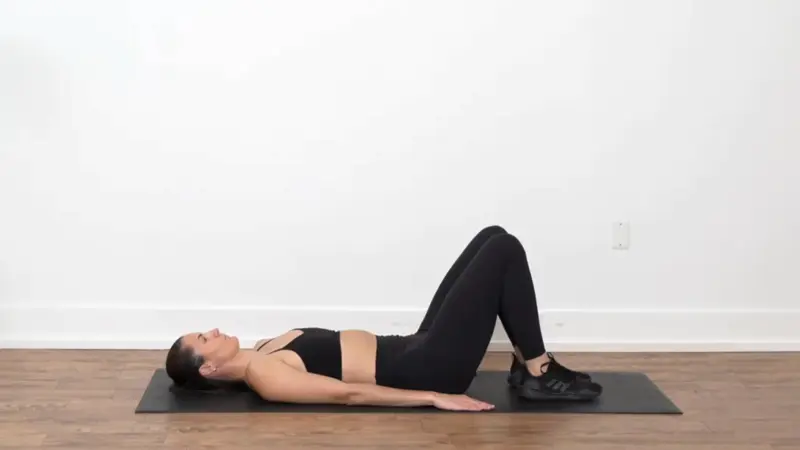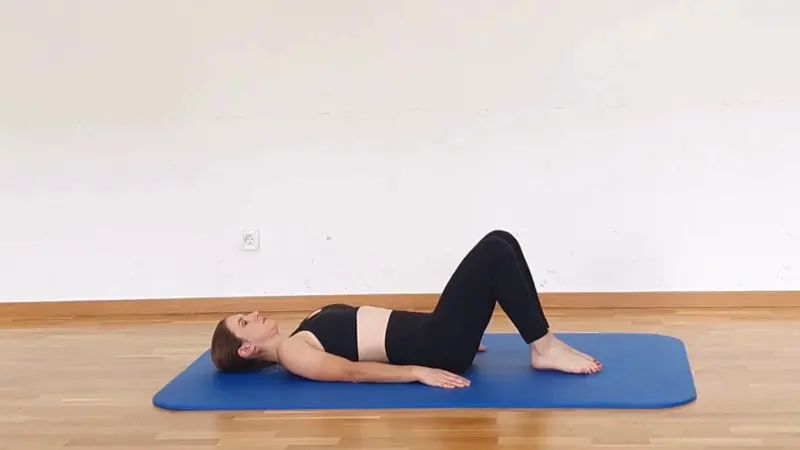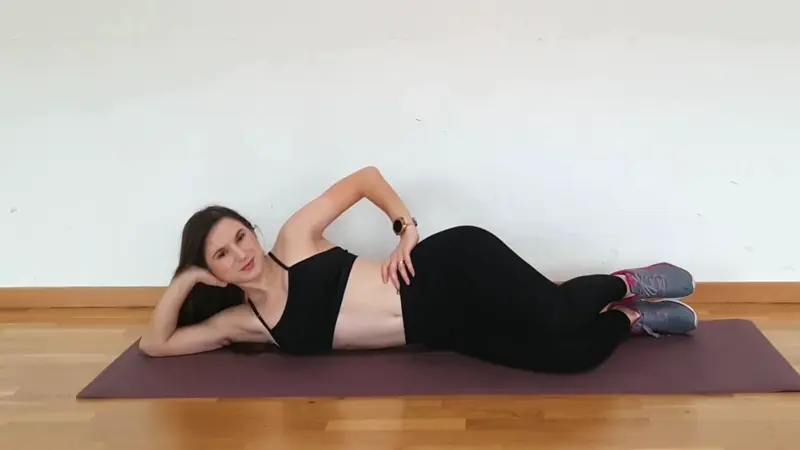If you’ve ever felt a sharp ache on the outside of your hip that makes walking, climbing stairs, or even lying on your side uncomfortable, you may be dealing with hip bursitis. This condition happens when the bursa — a small fluid-filled sac near the hip joint — becomes irritated. It’s one of the most common causes of outer hip pain, often referred to as Greater Trochanter Pain Syndrome.
The good news is that many people find relief through simple, at-home hip strengthening exercises and stretches that ease irritation, restore mobility, and support recovery. Below are seven physician- and physical therapy–backed options that target tight tissues and weak glute muscles. Done consistently, these movements can help you move with more comfort whether you’re bicycling, walking, or climbing stairs.
Learn more about hip bursitis and explore our guide to hip physical therapy for long-term treatment strategies.
Figure 4 Stretch
The figure 4 stretch is one of the most effective ways to release tension in the outer hip and glute muscles. By placing one ankle over the opposite knee, you create a gentle opening in the hip joint that targets tissues often irritated in hip bursitis. This stretch can improve flexibility, ease stiffness, and make daily movements like sitting, standing, and climbing stairs feel more comfortable.

A common mistake is pulling too hard on the leg, which may increase irritation instead of relief. Instead, focus on slow breathing and letting the hip relax naturally into the position. When practiced consistently, the figure 4 stretch supports hip mobility, reduces pressure on the bursa, and pairs well with other hip strengthening exercises in a physical therapy routine.
Pigeon Stretch
The pigeon stretch is a yoga-based movement often included in stretches for outer hip pain. It helps open the hip joint and lengthen deep hip rotator muscles that are commonly tight in people with hip bursitis. By improving flexibility in this area, the stretch reduces tension around the greater trochanter and can ease pressure on the inflamed bursa.

Because this stretch requires a deep forward position, it’s important not to force the body too far. Supporting the hip or torso with a pillow makes it more accessible for those with limited mobility. With regular practice, the pigeon stretch can restore hip mobility, reduce stiffness, and make daily movements like climbing stairs or standing from a chair more comfortable.
Standing Hip Flexor Stretch
The hip flexors often become shortened from long periods of sitting, which can place additional stress on the hip joint and aggravate bursitis. The standing hip flexor stretch provides a safe way to lengthen these muscles without kneeling, making it especially useful for people with knee pain or balance concerns.
When performed consistently, this stretch helps restore hip extension and can improve walking or bicycling mechanics. The key is to focus on gentle forward movement rather than arching the lower back. Over time, it supports smoother movement patterns and reduces the compensations that irritate the bursa.
Single-Leg Bridges
Weak glute muscles are a major contributor to hip bursitis, since they help stabilize the hip joint during movement. The single-leg bridge strengthens the glutes and core together, improving pelvic control and reducing pressure on the irritated bursa. It is one of the most effective hip strengthening exercises for long-term recovery.

Instead of thinking about lifting high, the focus should be on driving through the heel and keeping the motion controlled. This prevents the lower back from taking over and ensures the glutes are doing the work. Stronger glutes translate directly into more stability for walking, climbing stairs, and everyday activities that otherwise trigger pain.
Side-Lying Hip Abduction
The side-lying hip abduction is one of the most common exercises prescribed in physical therapy for bursitis. It targets the glute medius, a muscle essential for hip stability that often becomes weak when hip pain develops. Strengthening this muscle decreases stress on the hip joint and helps control the pelvis during walking.
Tips for success include:
- Keep hips stacked without rolling backward.
- Move slowly to maximize glute activation.
- Add a resistance band over time to progress strength.
Because weakness in the glute medius is strongly linked to Greater Trochanter Pain Syndrome, this exercise is a cornerstone of nearly every rehab program for hip bursitis.
Clamshells
The clamshell exercise is another foundational movement for strengthening the hip rotator muscles. By training the small stabilizers of the hip joint, clamshells reduce abnormal movement patterns that put extra strain on the bursa. They also build endurance in the muscles needed for prolonged standing and walking.

One common mistake is letting the pelvis tip backward. Keeping the core gently engaged ensures the motion comes from the hip itself. Consistently working clamshells builds stability in the lateral hip and complements other glute-focused exercises.
Reverse Clamshells
The reverse clamshell complements the standard version by targeting a slightly different set of hip rotator muscles. These muscles help control internal rotation of the hip, which is often overlooked but essential for balanced strength around the joint.
Patients in physical therapy frequently report less irritation with side sleeping and walking after practicing both clamshell variations together. The reverse clamshell is especially valuable for improving pelvic alignment and reducing the compensations that worsen hip bursitis.
Other Helpful Hip Exercises
Beyond these seven core moves, some people with hip bursitis also benefit from addressing related conditions. For example, strengthening and mobility work designed for hip tendonitis
or hip arthritis
can overlap with bursitis care, helping to protect the hip joint and improve long-term function.
Here are additional exercises from our library that can support recovery and hip health:
- Quad Stretch
- Knee-to-Chest Stretch
- Glute Bridge
- Straight Leg Raise
- Piriformis Stretch
It’s equally important to know what movements to avoid. Certain exercises can aggravate the condition, which we cover in detail in hip pain exercises to avoid.
Why These Hip Bursitis Exercises Work
Research shows that combining stretching with strengthening is more effective than rest alone (study). These movements target tight tissues, strengthen weak muscles, and create more stability in the hip joint. Over time, this combination helps reduce flare-ups and keeps you moving with confidence.
Learn more from trusted sources like Mayo Clinic and Harvard Health.
Take the Next Step in Your Recovery
Hip bursitis doesn’t have to control your daily life. The right combination of exercises can ease irritation, build strength, and help you return to activities you enjoy — whether that’s walking, climbing stairs, or cycling.
The Sporty Doctor App gives you guided mobility, stretching, and strengthening routines created by a physician specializing in sports medicine. You’ll learn safe progressions, track your improvements, and protect your hips for the long run.
Your body is built to move — let’s keep it that way. Download the Sporty Doctor app today and start your path to stronger, healthier hips.









